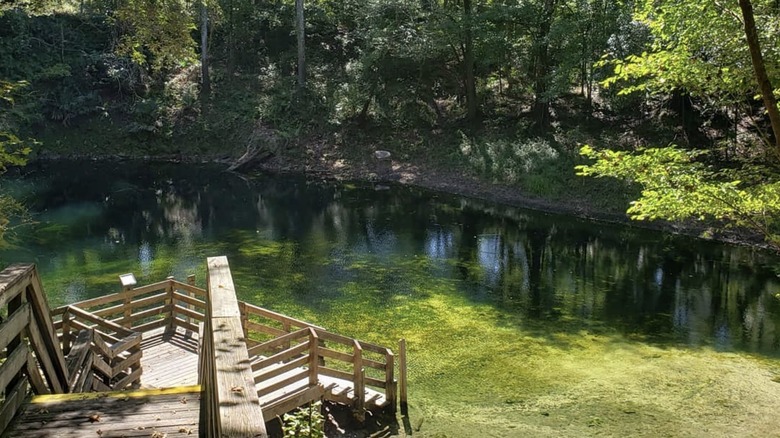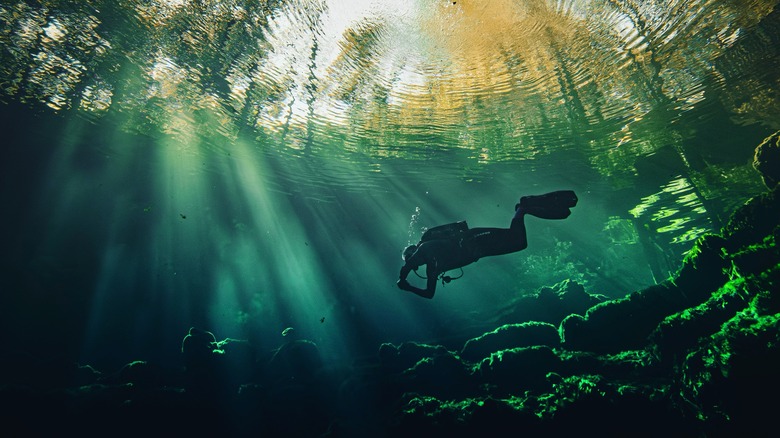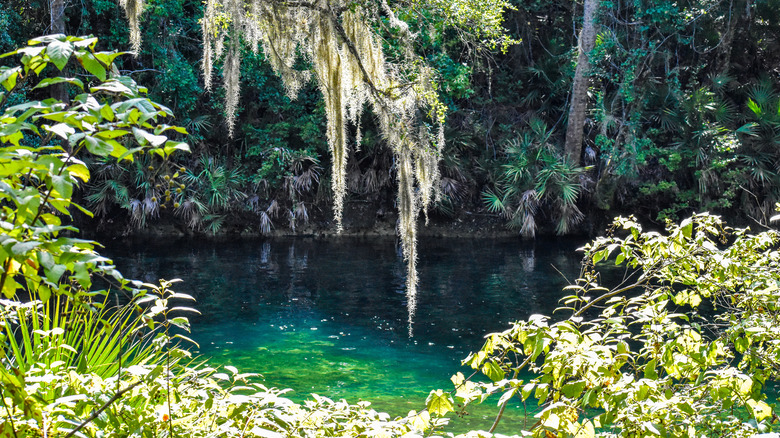Florida's 'Shortest River' Is A Picturesque Secluded Spring For Peaceful Hikes And Refreshing Swims
A secluded freshwater spring in north Florida is often dubbed the "shortest river in the world." But the picturesque Falmouth Springs in Suwannee County near the community of Live Oak isn't a river at all — it's an exposed underground stream that's only visible thanks to eons of erosion that caused the cavern above it to collapse. This "karst window" into the exposed cavern makes for a unique combination of hydrological wonder and geological anomaly. Visitors to the area can get an up-close look at this rare phenomenon, either by getting into the refreshing 72-degree spring on a hot summer day or by wandering its banks and taking in a uniquely Florida ecosystem.
Falmouth Springs, like other under-the-radar crystal clear springs in Florida, gushes to the surface from an underground cavern at a stunning 100,000 gallons per minute. Once it reaches the surface, the springs flow for about 450 feet before disappearing back underground and re-entering their subsurface course through what's called a swallet or a siphon. The water, during normal flows, is crystal clear and swimmers and divers are welcome to hop in and cool off on a hot summer day (although divers are cautioned to stay clear of the swallet, for safety's sake.
Get a look at an underground cavern without going underground
Falmouth Springs can be accessed at Falmouth Springs Park, which is maintained by the Suwanee River Water Management District. The 276-acre park is open to the public and located about 15 minutes northwest of Live Oak, just off of Florida Highway 90. Here, visitors can get a look at what an underground spring flowing through a cavern might look like, minus the top of the cavern. One of about 30 first-magnitude springs in Florida (natural springs that push at least 64 million gallons a day up from the aquifer) Falmouth Springs flow under a beautiful canopy of water oak and other common hardwoods before diving back underground and eventually emerging in the stories Suwannee River a few short miles to the west.
Falmouth Springs Park offers hiking and cycling trails and a great little picnic area. It's an excellent location for a day trip to the water to cool off, or as part of a larger trip to see more of Florida's unparalleled freshwater springs, like Ichetucknee Springs, a bright blue swimming hole protected as a state park. Visitors to the park can wander through groves of palmettos and they might see white-tailed deer, racoons, foxes and maybe even a rare gopher tortoise. The springs are part of a unique habitat in these stunning north Florida woods.
Falmouth is one of several natural springs worth a look
Locals who live in north Florida know all about the area's plentiful and stunning natural springs. But many visitors to the area are floored by the presence of these crystal clear spring vents that seem to pop up all over the region and serve as the ultimate contrast to the blackwater rivers the area is known for. Rivers like the Alapaha, Suwannee, Withlacoochee and Santa Fe all flow dark with tannin-stained waters. But their courses are often interrupted by cold, clear freshwater springs that freshen up the rivers' flows and, in the summer, cool them down.
These freshwater springs, like the nearby and beautiful Madison Blue Springs hidden in the Florida woodlands, offer incredible summertime swimming opportunities and year-round scuba diving, particularly cave-diving enthusiasts. When Spanish explorer Ponce de Leon arrived on Florida's Atlantic coast in 1513, he learned of these stunning freshwater springs and heard the legends of the Fountain of Youth and that those who drank from it would be inexplicably rejuvenated. There are literally dozens of freshwater springs within an easy drive of Live Oak, and there are more than 300 documented freshwater springs along the Suwannee River as it flows southwest to the Gulf of Mexico. And, for what it's worth, old Ponce never found his fountain of youth. When he returned to govern Florida in 1521, he was killed by the Indigenous tribes of the area.


